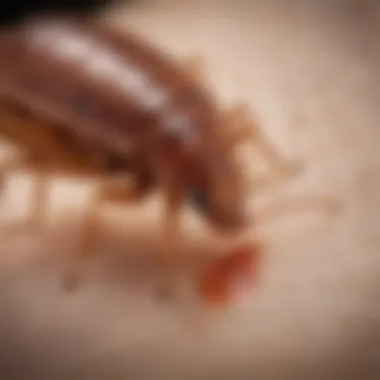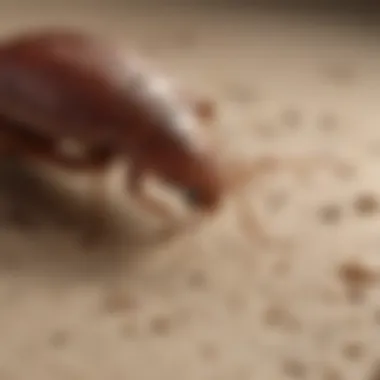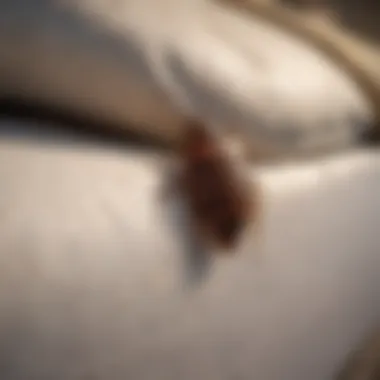How to Diagnose Bed Bug Bites: Symptoms & Identification


Intro
Bed bugs have become a growing concern in many households. They are small, blood-sucking parasites that often go unnoticed until they start causing discomfort. Recognizing their presence is crucial. Experienced housewives and homeowners need to identify bed bug bites accurately to tackle infestations effectively. This article will delve into pest identification, prevention strategies, and treatment options to enhance your understanding of managing these pests.
Pest Identification
Identifying bed bug bites relies on examining physical signs and symptoms.
Detailed Descriptions of Common Pests
• Bed Bugs: Small, flat, oval-shaped insects, usually brownish or reddish. Adults measure about 4-5 mm long. • Fleas: Typically, fleas are darker and more mobile than bed bugs, with a tendency to jump. They are smaller than bed bugs, around 1-3 mm. • Mosquitoes: These are larger, often with distinguishable long bodies. Their bites usually occur during evening or night times outdoors.
Signs and Symptoms of Infestations
Knowing how to spot bed bug bites is essential. Common signs include:
- Red or reddish-brown bumps: Often appear in clusters or lines on the skin.
- Itching and discomfort: Affected areas may be itchy, similar to other insect bites.
- Sleep disturbances: If you wake up with unexplained bites, this could signal an infestation.
- Dark spots: Bed bug excrement can appear as dark stains on sheets and mattresses.
It's crucial to differentiate between various insect bites, as treatment may differ significantly.
Prevention Strategies
Once pests are identified, preventing future infestations becomes vital.
Home Maintenance Tips for Pest Prevention
- Regularly vacuum carpets, rugs, and upholstery to remove eggs and larvae.
- Seal cracks and crevices in walls and around baseboards to prevent access.
- Reduce clutter to limit potential hiding spots for bed bugs.
Natural Deterrents and Barriers
- Essential oils: Peppermint and tea tree oil may repel bed bugs.
- Diatomaceous earth: This natural powder can kill bed bugs when they come into contact with it.
Treatment Options
If bed bug bites occur, proper treatment options should be considered.
Overview of Chemical vs. Natural Treatments
- Chemical treatments: Products like pyrethroids are common but should be used cautiously.
- Natural treatments: Employ options such as essential oils or diatomaceous earth if chemical pesticides are a concern.
Step-by-Step Guides for DIY Treatments
- Homemade spray: Mix water with essential oils in a spray bottle for quick treatment of bed bug bites.
- Heat treatment: Wash affected linens and clothing on high heat to kill eggs and bugs.
- Cold treatment: Place non-washable items in the freezer for several days to eliminate bugs.
Understanding Bed Bugs
In the quest to adequately address bed bug bites, it is vital to first understand the pests themselves. Bed bugs, scientifically known as Cimex lectularius, are small, wingless insects that primarily feed on the blood of humans and animals. They are nocturnal and often hide in cracks and crevices close to where people sleep. Awareness of their biology and behavior is important for recognizing signs of bites and understanding how to mitigate infestations.
Knowing the characteristics of bed bugs enhances an individual’s ability to recognize an infestation at an early stage. This recognition can prevent further bites and more extensive problems associated with bed bug spread. A clear understanding of bed bug habits can provide insights into why certain symptoms present themselves in specific ways, such as the clustering of bites often observed.
Biology and Behavior of Bed Bugs
Bed bugs are small, typically measuring about 4 to 5 mm in length. They undergo a series of molts as they grow, transitioning from nymph to adult. Their bodies are flat and reddish-brown, which allows them to hide easily in small crevices. The biology of these insects directly impacts their behavior, particularly their feeding habits. Bed bugs can survive months without a meal, so their presence does not always correlate with visible signs of infestation.


A well-known trait is their penchant for feeding at night. They are attracted to the warmth and carbon dioxide emitted by sleeping humans. Once they find a host, they pierce the skin using their elongated mouthparts to extract blood. This feeding process can last anywhere from three to ten minutes. Their feeding frequency varies based on the availability of hosts, making them a persistent issue in infested environments.
Common Habitats of Bed Bugs
Bed bugs tend to thrive in places where people sleep. This includes homes, hotels, and hostels, making travel a potential risk factor for exposure. Their preferred hiding spots include:
- Mattresses and Box Springs: Bed bugs often hide in the seams and folds of mattresses.
- Furniture Joints: They find refuge in furniture, especially in joints and under cushions.
- Baseboards: Cracks in baseboards can also provide ideal hiding places.
- Luggage: Infestations can spread when travelers unknowingly carry bed bugs home in their luggage.
While cleanliness does not have a direct correlation with bed bug infestations, clutter can provide additional hiding spots, making it harder to identify and eliminate them. Recognizing these common habitats encourages preventive measures, ensuring that individuals remain vigilant against potential infestations.
"Properly understanding bed bugs and their behavior is the first step toward effective diagnosis and management of their bites."
Educating oneself about bed bugs equips homeowners and housewives with the necessary tools to identify signs of bites and understand their implications. Once an understanding is established, it can lead to effective strategies for both diagnosis and control.
Identifying Bed Bug Bites
Identifying bed bug bites is a crucial step in managing potential infestations. Distinguishing between different types of insect bites helps in determining the appropriate response. Bed bug bites can often be mistaken for other insect stings or bites, leading to confusion and ineffective treatments. Recognizing the specific characteristics and symptoms associated with these bites plays a vital role in both prevention and treatment strategies.
Characteristics of Bed Bug Bites
Bed bug bites have distinct features that set them apart from other insect bites. Typically, they appear as small, red welts on the skin, often organized in a linear or clustered pattern. This pattern can be particularly telling, as many other insects tend to bite sporadically. Bed bug bites can also be itchy, and the severity of the itch can differ from person to person.
Some individuals may develop a more pronounced allergic reaction, resulting in larger hives or swelling at the bite sites. Generally, these bites may take hours or even days to become fully visible, which can complicate the identification process. The bites may not hurt immediately, making it easy for a person to overlook them.
Common Symptoms Associated with Bites
In addition to the visual signs, other symptoms can accompany bed bug bites. These include:
- Itching: This is often the most noticeable symptom and can lead to scratching, which can introduce infections.
- Swelling: Some people may experience localized swelling around the bite area.
- Redness: The skin around the bite may appear red and inflamed.
- Secondary infections: Scratching the bites can lead to open wounds and infections, necessitating medical treatment.
Awareness of these symptoms is important for an effective response, as they can guide whether to self-treat or seek medical advice.
Distinguishing Bed Bug Bites from Other Insect Bites
Different insects can result in bites that look similar to bed bug bites. Therefore, understanding how to distinguish bed bug bites is critical. For example, mosquito bites usually appear as raised bumps and can cause significant localized irritation but do not typically follow a linear pattern. Flea bites, on the other hand, tend to cluster around the ankles or legs. By noting the pattern and location of the bites, one can make more informed decisions about potential pest control needs.
"Understanding the differences between bed bug bites and those from other insects is vital. This knowledge allows homeowners to address pest issues effectively and take preventive measures."
The Diagnostic Process
Understanding the diagnostic process for bed bug bites is essential for accurate identification and effective management of these pests. This process not only involves recognizing the physical signs of bites but also integrating behavioral observations and seeking professional advice when necessary. By following these steps, homeowners can gain a clearer understanding of a potential infestation and take appropriate measures to address it.
Physical Examination of Bites
A thorough physical examination of the bites is the first step in diagnosing whether bed bugs are responsible. Bed bug bites typically present as small, red welts that may be itchy. They usually appear in a linear pattern or cluster on the skin. It is important to note that individuals may react differently to bites. Some people will experience severe allergic reactions, while others may have mild irritation.
The key characteristics to look for in bed bug bites include:
- Timing: Bites often occur at night when bed bugs are active.
- Location: Common areas for bites include the arms, neck, and face, as these are usually exposed while sleeping.
- Duration: Bites may last for several days, gradually resolving themselves.
- Appearance: Compared to other insect bites, bed bug bites are generally flat or raised and may develop into blisters.
To confirm that you are dealing with bed bug bites, compare them against information found on resources like Wikipedia and credible insect-related studies.
Gathering Behavioral Information
Next, it is crucial to gather behavioral information related to the occurrence of bites. Some behavioral aspects to consider include:


- Sleeping Patterns: Have you noticed any signs of restlessness during sleep? Bed bugs typically feed on their hosts when they are at rest.
- Environmental Changes: Have you recently traveled, stayed in a hotel, or acquired used furniture? These activities can introduce bed bugs into your home.
- Signs of Bed Bugs: Observations of actual bed bugs or their skins, eggs, or fecal matter should prompt further investigation.
Inquiring about these behaviors can provide valuable context that supports the diagnosis of bed bug bites. Documenting instances of bite occurrences and correlating them with these behavioral signs enhances your understanding of the issue.
Consultation with a Pest Control Professional
If a physical examination and behavioral observations indicate a possible bed bug issue, consulting with a pest control professional is the next logical step. Pest control experts carry the knowledge and tools necessary to identify and treat infestations effectively. They can conduct thorough inspections of your home, including hidden areas such as:
- Mattresses and Bedding: These are primary habitats for bed bugs.
- Cracks and Crevices: Bed bugs are adept at hiding; thus, thorough inspections in unlikely places are essential.
In engaging a professional, ensure that they employ a methodical approach to pest control. This may include not only eradication but also preventive measures to avoid future infestations. Additionally, establish a communication channel with them, so any emerging problems can be addressed promptly.
"A well-informed diagnosis is the bedrock of effective pest control strategies."
Common Misconceptions about Bed Bug Bites
Understanding the common misconceptions surrounding bed bug bites is essential for effective pest management and treatment. Many myths can lead to confusion and may worsen existing infestations. This section aims to clarify these misconceptions and highlight the facts that housewives and homeowners should know.
Myths Related to Bed Bug Infestations
- Bed Bugs are Only Found in Dirty Homes
A prevalent belief is that bed bugs thrive in filthy environments. This is not true. Bed bugs can infest any location, regardless of cleanliness. They prefer places close to their hosts, which can be neat and tidy or cluttered. - Only Poorly Maintained Apartments Get Infested
Bed bug infestations occur in various living situations, including luxury hotels and upscale residences. It can happen to anyone, not just in economically disadvantaged areas. - You Can Easily Spot Bed Bugs
Some assume that bugs will be visible on beds or walls. However, they often hide in tiny crevices and can be hard to detect without proper inspection. Their size and ability to conceal themselves make this process challenging. - Bed Bugs Only Bite at Night
While it's true that bed bugs are mostly nocturnal, they can bite during the day as well, particularly if they sense a host near them. - Bites Can Only Be Caused by Bed Bugs
People may see bite marks and immediately assume bed bugs are at fault. However, many insects can cause similar bite marks, including fleas and mosquitoes. Proper diagnosis is critical.
Truths About Bed Bugs
- Bed Bugs Are Blood Feeders
Bed bugs feed on the blood of humans and animals. They need this nourishment to grow and reproduce. Understanding their feeding habits helps mitigate emotional responses about bites. - Bites May Take Time to Appear
After being bitten, some individuals may not exhibit symptoms for days. This delay can lead to misattribution of bites, making it difficult to act quickly. - Infestations Can Be Treated
Treatment options exist for eliminating bed bugs and managing bites. Understanding these options allows homeowners to take proactive steps. - Bed Bug Bites Can Cause Allergic Reactions
Some people may experience more severe symptoms or allergic reactions, necessitating medical treatment. This underscores the need for taking these bites seriously. - Professional Help is Often Required
Given their resilience, bed bugs are often best dealt with by pest control professionals rather than DIY methods. Seeking expert assistance early can save time and effort.
Understanding these myths and truths about bed bugs is crucial for any homeowner. Misconceptions can lead to misdiagnosis and inadequate treatment.
By dispelling myths and reinforcing truths, readers will be better prepared to handle the realities of bed bug infestations and understand the importance of correct identification and treatment.
Preventive Measures Against Bed Bug Bites
Preventing bed bug bites is crucial for maintaining a pest-free environment in your home. With a clear understanding of how to identify potential risks, you can take proactive measures to keep these pests at bay. This section discusses the importance of recognizing signs of infestation and outlines effective practices that can significantly reduce the chances of bed bug encounters.
Recognizing Signs of Infestation
Identifying early signs of bed bug infestation is essential. Early detection can prevent the situation from escalating and save you from discomfort and financial burden. Common indicators include:
- Bite Marks: Clusters of small, red, itchy bites on exposed skin.
- Dark Spots: Tiny black droppings on bedding or surfaces, which are excretions from bed bugs.
- Eggs and Shells: Small, white, oval-shaped eggs may be found in crevices or near infested areas.
- Musty Odor: A strong, musty smell may indicate a high population of bed bugs.
Being vigilant and inspecting your sleeping area regularly can lead to quick action, reducing the infestation risk.
Best Practices for Bed Bug Prevention
To effectively prevent bed bug bites, incorporating best practices into your routine is key. Here are some effective strategies:
- Regular Inspections: Frequently check bedding, furniture, and luggage for signs of bed bugs. Look inside mattress seams, headboards, and baseboards.
- Use Protective Covers: Encase mattresses and pillows in protective encasements. These covers prevent bed bugs from entering or exiting.
- Be Cautious During Travel: Inspect hotel rooms upon arrival. Avoid placing luggage on the bed or floor. Instead, use luggage racks.
- Keep Clutter to a Minimum: Reducing clutter helps eliminate potential hiding places for bed bugs.
- Wash and Dry Bedding: Regularly wash and dry bedding, linens, and clothing on hot settings to kill any potential bed bugs.
Maintaining a proactive stance against bed bugs is more effective than dealing with an infestation after it has occurred.
By understanding and implementing these preventive measures, you can significantly reduce the likelihood of bed bugs becoming a problem in your home. This not only protects your family from bites but also contributes to overall well-being and peace of mind.
Treatment Options for Bed Bug Bites
Understanding available treatment options for bed bug bites is critical for anyone facing these unwelcome visitors. Prompt treatment can mitigate discomfort and prevent complications. Recognizing the various ways to alleviate the effects of bites not only enhances one’s quality of life but also aids in managing any potential associated risks. The treatment you choose may depend on the severity of your symptoms, any underlying conditions, and personal preferences.


Over-the-Counter Treatments
Over-the-counter treatments are typically the first line of defense for bed bug bites. These options are widely accessible and effective for managing mild symptoms.
- Antihistamines: Medications like diphenhydramine (Benadryl) can help reduce itching and swelling associated with bites. These can be found at local pharmacies and often provide quick relief.
- Hydrocortisone Cream: This topical steroid cream can be applied directly to the affected area. It decreases inflammation and provides temporary alleviation from itchiness. It is advisable to follow the instructions on the label for the best results.
- Calamine Lotion: This can soothe irritated skin and relieve itching. Applying calamine lotion to bites can create a soothing barrier and is safe for most individuals.
Using these treatments often leads to a reduction in symptoms. However, it is important to monitor how your skin reacts, as sensitivity may occur.
Prescription Options for Severe Reactions
For those experiencing severe reactions to bed bug bites, prescription treatments may be necessary. When over-the-counter solutions are ineffective, consulting a healthcare provider is crucial.
- Stronger Corticosteroids: A doctor may prescribe a stronger topical corticosteroid for significant inflammation or severe reactions. These prescriptions can provide quicker and more effective relief.
- Oral Steroids: In cases of intense allergic reactions, oral corticosteroids may be recommended. They can reduce swelling and manage systemic symptoms effectively.
- Antibiotics: If a secondary infection develops due to excessive scratching, antibiotics may be prescribed to treat this complication. It’s vital to treat any infections promptly to avoid further health issues.
Each of these prescription options offers a targeted way to manage severe symptoms effectively. It is essential to have a discussion with a healthcare professional before starting any new treatment.
Home Remedies and Their Efficacy
Some individuals opt for home remedies to treat bed bug bites. While the effectiveness of these methods can vary, they are often considered safe and accessible.
- Cold Compress: Applying a cold compress can help reduce swelling and numb the area temporarily. This method is simple and provides immediate relief for some people.
- Aloe Vera: This natural remedy has soothing properties. Applying aloe vera gel helps to cool down irritation and may promote healing.
- Baking Soda Paste: Mixing baking soda with water to form a paste can be applied to the bites. Some people find this alleviates itchiness effectively.
While home remedies can provide mild relief, it's essential to recognize their limitations. If symptoms persist or worsen, seeking professional medical treatment is advised.
When to Seek Professional Help
The decision to engage a pest control professional can be a pivotal moment in addressing a bed bug infestation. While minor infestations might be manageable through personal efforts, certain signs necessitate expert intervention. Understanding when to seek professional help is crucial for efficient and long-lasting solutions. This section illuminates key reasons and factors guiding this important decision.
Signs Indicating a Need for Expert Intervention
Recognizing specific signs can clarify when you should not tackle a bed bug issue alone. Here are some critical indicators:
- Severe Reactions: If individuals show extreme allergic reactions such as swelling or difficulty breathing, medical attention is essential. This may signal the need for professional pest control.
- Rapidly Expanding Infestation: If bed bugs are spreading quickly across multiple rooms or floors in your home, the situation may require immediate professional assessment and elimination.
- Failure of Home Treatments: If over-the-counter products and home remedies are not yielding results, specialists can provide effective solutions tailored to your unique problem.
- Presence of Eggs or Nymphs: Finding bed bug eggs or nymphs indicates a breeding population. This suggests a more complex infestation that typically necessitates comprehensive treatment plans only experts can provide.
Engaging professionals ensures a thorough evaluation and eradication strategy, significantly decreasing the likelihood of future infestations.
Finding a Qualified Pest Control Specialist
When it is clear that professional help is needed, the next step is to locate a reputable pest control specialist. The following guidelines can assist homeowners in this process:
- Research and Reviews: Start by examining online reviews and testimonials. Websites such as Reddit or Facebook can be good sources for community experiences and recommendations.
- Credentials: Verify that the pest control professional holds appropriate licenses and certifications. This adds a layer of assurance regarding their expertise and compliance with industry standards.
- Experience with Bed Bugs: Ensure that your chosen specialist has specific experience dealing with bed bug infestations. Pest management can vary widely, and specialists familiar with bed bugs will have tailored strategies.
- Comprehensive Solutions: Inquire about the methods they use for bed bug detection and elimination. Effective treatments often require a combination of chemical and non-chemical methods, such as heat treatment.
Engaging a qualified pest control expert can make the eradication process smoother and more successful. Being proactive and informed not only helps deal with the current situation but also aids in preventing future infestations.
Epilogue
In the context of diagnosing bed bug bites, this concluding section emphasizes the importance of understanding the complexities involved in recognizing and addressing these pests. Effective management hinges not only on proper identification of the bites themselves but also on comprehensifying the behavior and habitats of bed bugs. This multi-faceted approach enables homeowners to tackle potential infestations proactively.
Recap of Key Points
- Understanding Bites: Bed bug bites often appear as small, reddish welts, sometimes with a clear center. Recognizing this allows for quicker diagnosis.
- Symptoms: Common symptoms may include intense itching and discomfort, which can escalate to secondary infections if not managed.
- Distinction from Other Bites: It is crucial to differentiate bed bug bites from those of mosquitoes or fleas. Bed bugs favor multiple bites in a linear pattern.
- Professional Consultation: Engaging with pest control specialists can provide insights into effective treatment options and confirm a bed bug infestation.
This recap highlights the essential elements in the diagnostic process, ensuring readers are well-informed about bed bug bites and how best to address them.
Final Thoughts on Bed Bug Management
Managing bed bugs requires not only awareness but also a proactive strategy in prevention and treatment. With the knowledge gained from this article, homeowners can take charge of their living environments. Regular inspections, understanding signs of infestation, and maintaining cleanliness can significantly reduce risk.
Further, consultations with qualified pest control services are invaluable. These experts employ integrated pest management techniques that combine both chemical and non-chemical methods to eliminate infestations effectively. Staying informed on such management practices fosters a safer and more comfortable home.
"An ounce of prevention is worth a pound of cure."



